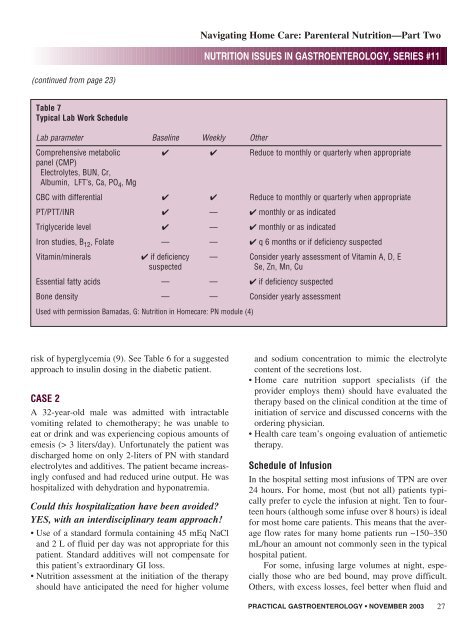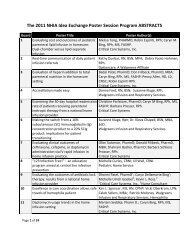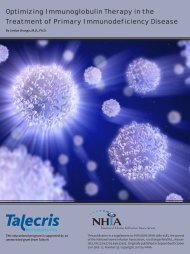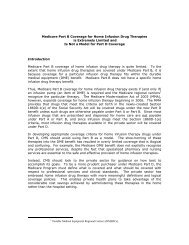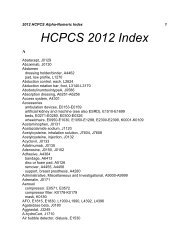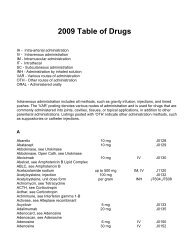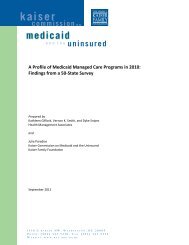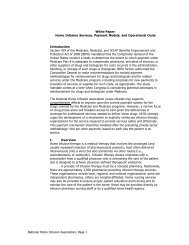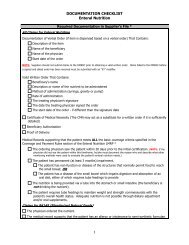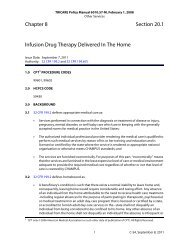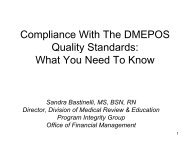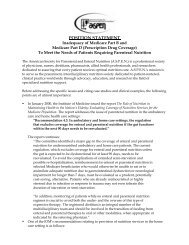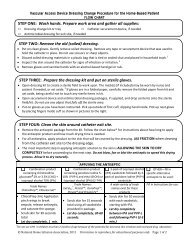Navigating Home Care: Parenteral Nutrition—Part Two
Navigating Home Care: Parenteral Nutrition—Part Two
Navigating Home Care: Parenteral Nutrition—Part Two
Create successful ePaper yourself
Turn your PDF publications into a flip-book with our unique Google optimized e-Paper software.
<strong>Navigating</strong> <strong>Home</strong> <strong>Care</strong>: <strong>Parenteral</strong> <strong>Nutrition—Part</strong> <strong>Two</strong><br />
NUTRITION ISSUES IN GASTROENTEROLOGY, SERIES #11<br />
(continued from page 23)<br />
Table 7<br />
Typical Lab Work Schedule<br />
Lab parameter Baseline Weekly Other<br />
Comprehensive metabolic ✔ ✔ Reduce to monthly or quarterly when appropriate<br />
panel (CMP)<br />
Electrolytes, BUN, Cr,<br />
Albumin, LFT’s, Ca, PO 4 , Mg<br />
CBC with differential ✔ ✔ Reduce to monthly or quarterly when appropriate<br />
PT/PTT/INR ✔ — ✔ monthly or as indicated<br />
Triglyceride level ✔ — ✔ monthly or as indicated<br />
Iron studies, B 12 , Folate — — ✔ q 6 months or if deficiency suspected<br />
Vitamin/minerals ✔ if deficiency — Consider yearly assessment of Vitamin A, D, E<br />
suspected<br />
Se, Zn, Mn, Cu<br />
Essential fatty acids — — ✔ if deficiency suspected<br />
Bone density — — Consider yearly assessment<br />
Used with permission Barnadas, G: Nutrition in <strong>Home</strong>care: PN module (4)<br />
risk of hyperglycemia (9). See Table 6 for a suggested<br />
approach to insulin dosing in the diabetic patient.<br />
CASE 2<br />
A 32-year-old male was admitted with intractable<br />
vomiting related to chemotherapy; he was unable to<br />
eat or drink and was experiencing copious amounts of<br />
emesis (> 3 liters/day). Unfortunately the patient was<br />
discharged home on only 2-liters of PN with standard<br />
electrolytes and additives. The patient became increasingly<br />
confused and had reduced urine output. He was<br />
hospitalized with dehydration and hyponatremia.<br />
Could this hospitalization have been avoided<br />
YES, with an interdisciplinary team approach!<br />
• Use of a standard formula containing 45 mEq NaCl<br />
and 2 L of fluid per day was not appropriate for this<br />
patient. Standard additives will not compensate for<br />
this patient’s extraordinary GI loss.<br />
• Nutrition assessment at the initiation of the therapy<br />
should have anticipated the need for higher volume<br />
and sodium concentration to mimic the electrolyte<br />
content of the secretions lost.<br />
• <strong>Home</strong> care nutrition support specialists (if the<br />
provider employs them) should have evaluated the<br />
therapy based on the clinical condition at the time of<br />
initiation of service and discussed concerns with the<br />
ordering physician.<br />
• Health care team’s ongoing evaluation of antiemetic<br />
therapy.<br />
Schedule of Infusion<br />
In the hospital setting most infusions of TPN are over<br />
24 hours. For home, most (but not all) patients typically<br />
prefer to cycle the infusion at night. Ten to fourteen<br />
hours (although some infuse over 8 hours) is ideal<br />
for most home care patients. This means that the average<br />
flow rates for many home patients run ~150–350<br />
mL/hour an amount not commonly seen in the typical<br />
hospital patient.<br />
For some, infusing large volumes at night, especially<br />
those who are bed bound, may prove difficult.<br />
Others, with excess losses, feel better when fluid and<br />
PRACTICAL GASTROENTEROLOGY • NOVEMBER 2003 27


